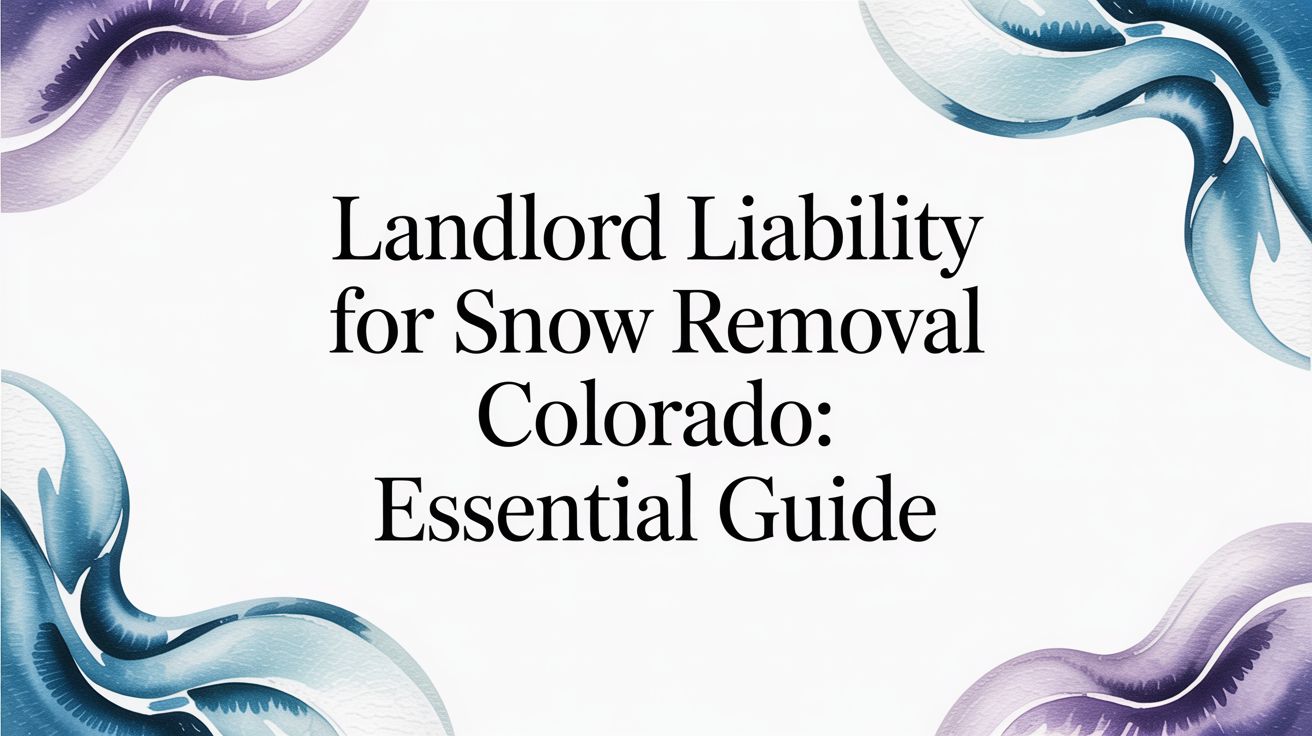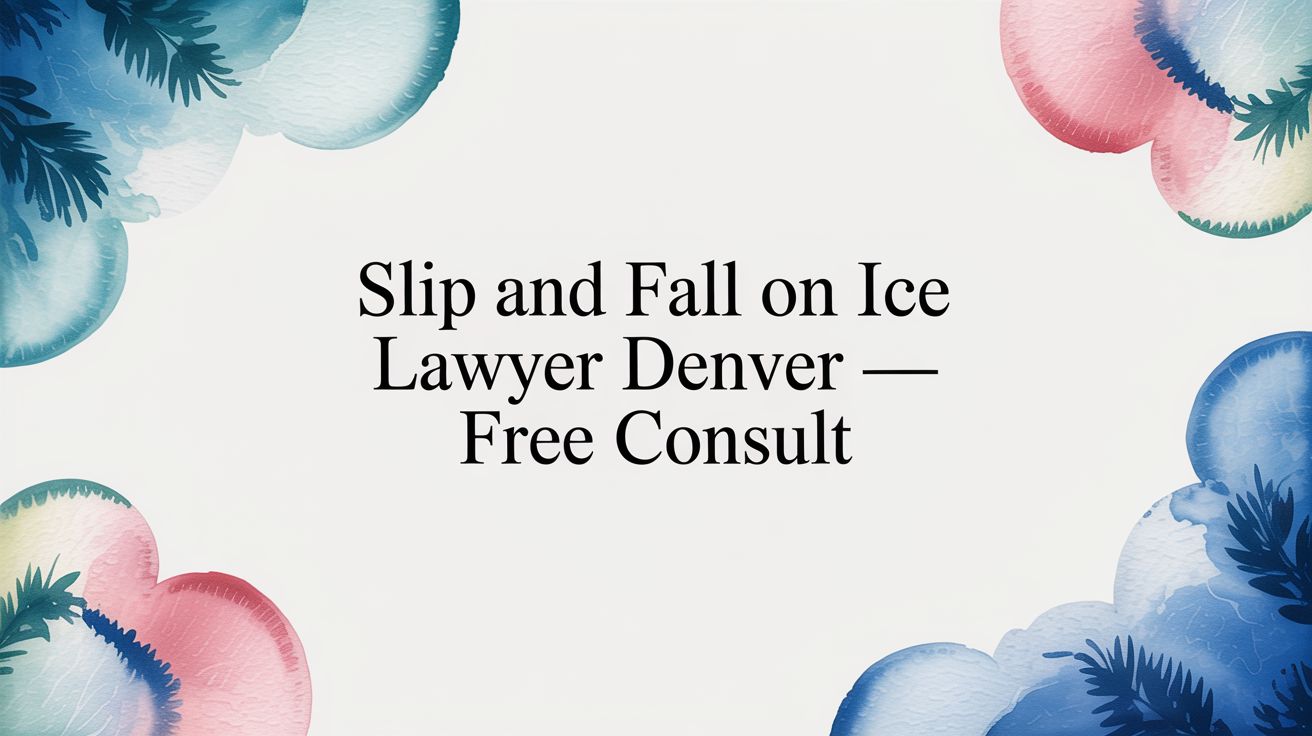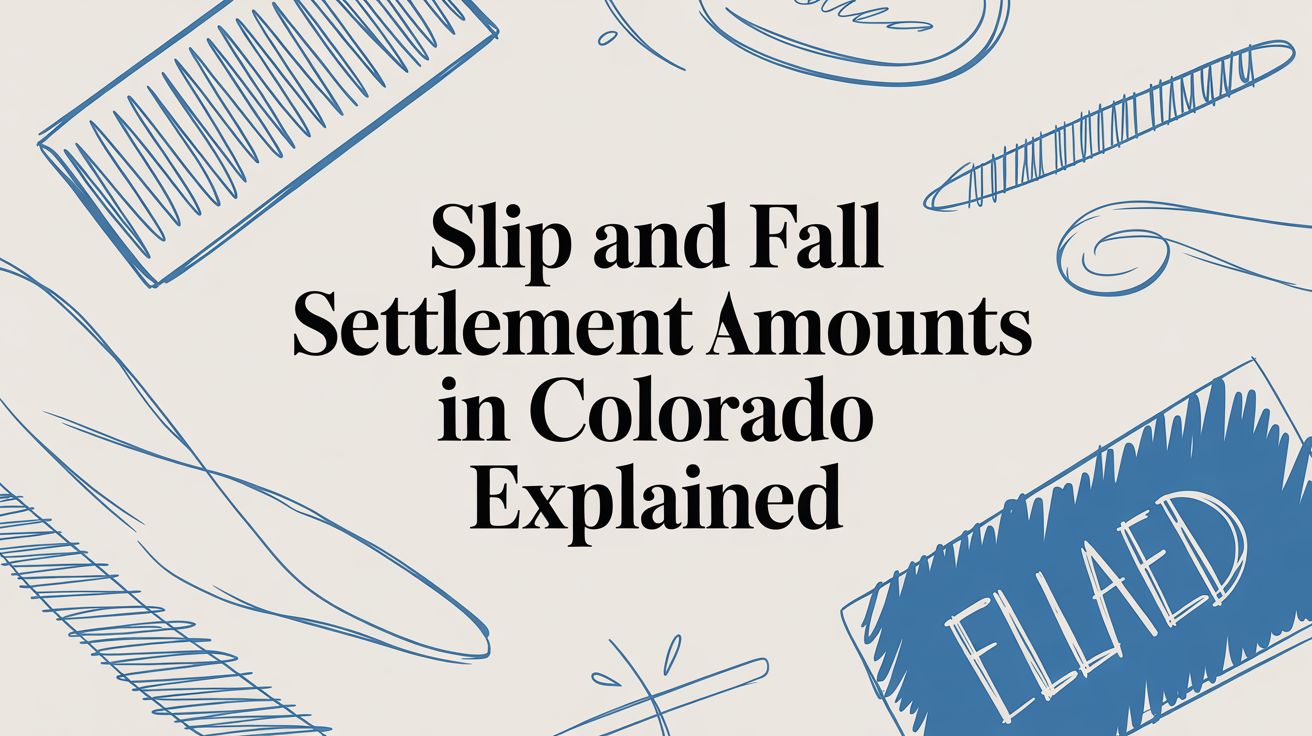Table of Contents
When you visit a store in Denver, an apartment complex in Aurora, or even a friend's house in Boulder, you have a reasonable expectation of safety. You don't expect to slip on a wet floor, trip over a broken step, or become the victim of an attack in a poorly lit parking lot.
At its heart, premises liability law is the legal framework that holds property owners accountable for injuries that happen on their property due to negligence. At Conduit Law, we see it as a fundamental rule of responsibility: if you own or control a property in Colorado, you have a legal obligation to keep it reasonably safe for others. If that duty is breached and you are injured, you have the right to seek justice.
Our team, led by managing attorney Elliot Singer, has recovered over $50 million for personal injury victims across Denver. We transform complex legal concepts like premises liability into streamlined, action-oriented solutions for our clients. This guide explains what you need to know about this critical area of personal injury law.
Understanding the Basics of Premises Liability
Think of a property owner as the captain of a ship. They are responsible for the safety of everyone who comes aboard. Whether it’s a bustling Denver grocery store, a modern apartment building, or a private home, the owner must address dangerous conditions that could foreseeably harm someone. When they fail in this duty and someone gets hurt, a premises liability claim is born.
This isn’t an obscure legal theory; it's a reality that affects thousands of Coloradans every year. Premises liability cases—which cover everything from slip-and-falls to negligent security—make up roughly 17% of all personal injury claims filed in the U.S.
The financial stakes can be high. While the average settlement for cases that don't require surgery often falls between $10,000 and $50,000, severe injuries can easily push a case value well past $100,000. You can explore more personal injury law statistics to understand how common these incidents are.
The Four Pillars of a Successful Claim
To win a premises liability case in Colorado, you can't just show that you got hurt on someone else's property. You and your attorney must build a solid case by proving four specific elements. If even one of these pillars is weak, the entire claim can collapse.
Let's break them down.
The Four Pillars of a Colorado Premises Liability Claim
Here's a quick overview of the four essential elements you must prove to build a successful premises liability case in Colorado.
| Legal Pillar | What It Means for Your Case |
|---|---|
| Duty of Care | You have to show the property owner had a legal responsibility to keep you safe from unreasonable harm. |
| Breach of Duty | Next, you must prove the owner failed in that duty, either by acting negligently or by failing to act at all. |
| Causation | This is the direct link. You need to connect the owner's failure directly to the accident that caused your injuries. |
| Damages | Finally, you must demonstrate that you suffered actual harm that can be measured financially (medical bills, lost pay, etc.). |
Aligning all four of these elements is where the real work of a premises liability case lies. For example, it’s not enough to say you slipped on a wet floor. You must prove the owner knew (or should have known) about the spill and did nothing to clean it up or warn you. This is where the complexities of what is premises liability law truly come into play, and why having an experienced legal guide is so important.
At Conduit Law, our attorneys start building a case around these four pillars from day one. We dig deep into the facts, investigating every detail to forge a clear, undeniable link between the property owner's negligence and the harm you've suffered.
Understanding a Property Owner's Duty of Care
The entire concept of premises liability boils down to one core principle: the "duty of care." This isn’t a vague moral obligation; it’s a specific legal responsibility a property owner has to keep people on their property safe from harm. But here’s the key—that responsibility isn't a one-size-fits-all deal in Colorado.
In our state, the level of care a property owner owes you depends entirely on why you were on their property in the first place. The law sorts visitors into three distinct groups, and identifying which one you fall into is a crucial first step in any potential claim.
Your Legal Status Determines the Owner's Responsibility
Colorado law is very clear: your status as a visitor sets the legal standard for what the property owner should have done to prevent your injury. Let's break down the three categories.
- Invitees: This is the highest level of protection. An invitee is someone invited onto a property for the owner's commercial benefit. Think of customers in a Denver retail shop, diners at a restaurant on Larimer Square, or tenants in an apartment building. You are there for business purposes, and the owner has a strong obligation to protect you.
- Licensees: A licensee is a social guest. You are on the property with the owner's permission but for your own benefit. Being invited to a friend's backyard barbecue in the Highlands or attending a holiday dinner at a relative’s house are perfect examples.
- Trespassers: This one is straightforward. A trespasser enters a property without any permission from the owner. The duty of care owed here is minimal, though an owner still cannot intentionally cause them harm.
This legal status is the foundation for proving the four essential elements of a premises liability claim: Duty, Breach, Causation, and Damages.
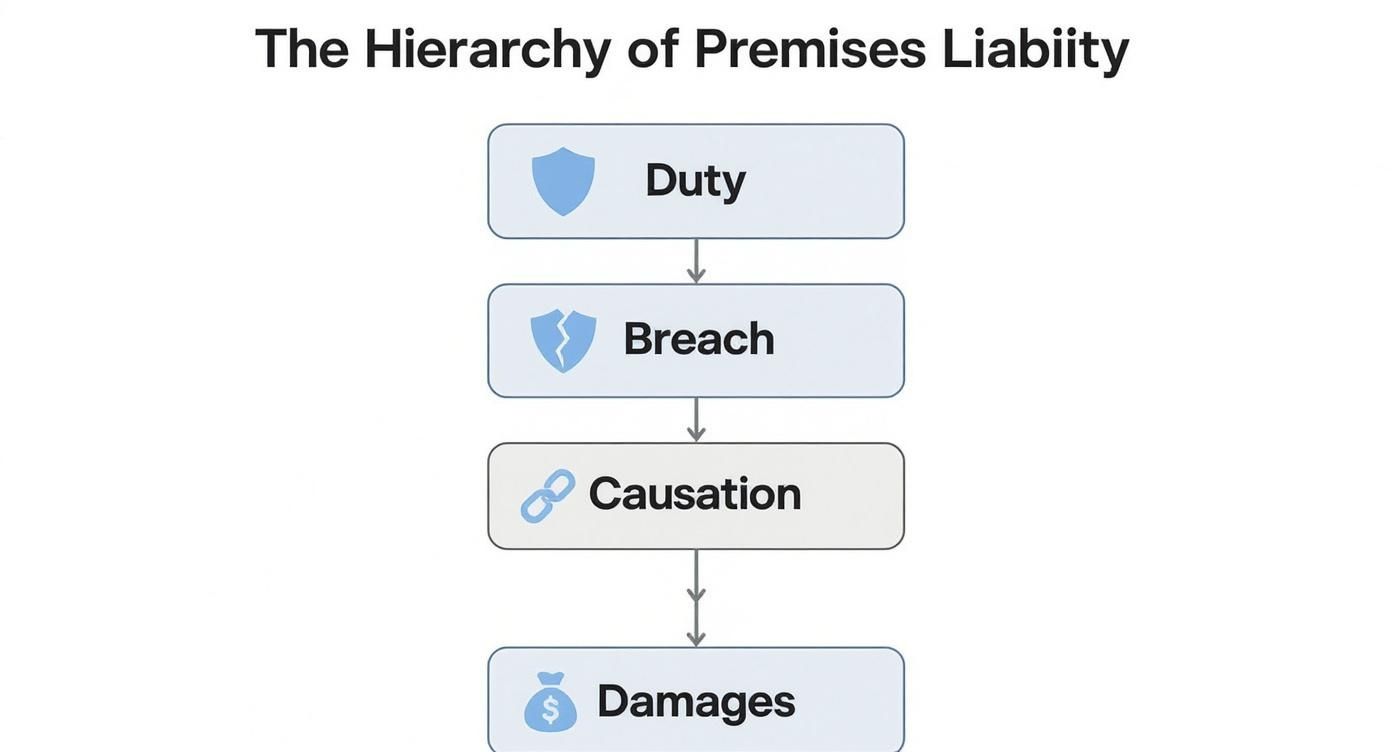
As you can see, a successful claim is built step-by-step. It all starts with establishing that the owner had a legal duty, which was then breached, and that breach directly caused real, measurable harm.
What Is "Reasonable Care" in Practice?
"Reasonable care" might sound fuzzy, but in the eyes of the law, it’s a practical standard. It’s what an ordinary, sensible person would do in a similar situation to prevent others from getting hurt. This standard changes dramatically based on your visitor status.
A property owner’s responsibility isn't just about reacting to accidents; it’s about proactively identifying and addressing potential dangers before anyone gets hurt.
For an invitee, the property owner is held to the highest standard. They must do more than just fix dangers they know about; they have a duty to actively and regularly inspect their property to find hidden hazards you wouldn’t expect.
- Example for an Invitee: The manager of a grocery store on Colfax Avenue knows that snow gets tracked inside during the winter. They have a duty to implement a system for staff to regularly mop the entrance and check the aisles for puddles. Failing to do so is a breach of their duty to you, their customer.
For a licensee, the bar is a bit lower. A property owner must warn you about known dangers that you are unlikely to spot on your own. Critically, however, they generally do not have to search for unknown problems.
- Example for a Licensee: If you are at a friend's house for dinner and they know one of their porch steps is wobbly, they have a duty to warn you. If they say nothing and you trip and fall, they have breached that duty of care.
Finally, for a trespasser, the owner's only real duty is to avoid causing willful or wanton injury. A major exception is the "attractive nuisance" doctrine, which applies to children. If an owner has something on their property that could lure a child in—like an unfenced swimming pool—they have a higher duty to secure it.
Understanding your visitor status is the key that unlocks your case. It defines what the owner should have done and is the very first pillar we at Conduit Law establish when building your claim.
Common Accidents Covered by Premises Liability
When you hear “premises liability,” the classic image that comes to mind is someone slipping on a wet floor. While that’s a perfect example, the legal principle is much broader, covering a whole host of incidents where a property owner’s negligence causes harm.

Understanding what is premises liability law means looking beyond the obvious. It’s about recognizing that property owners in Denver and across Colorado are responsible for a wide range of potential dangers.
These cases are on the rise. A recent Torts Litigation Report from Lex Machina revealed that premises liability lawsuits in U.S. federal courts have hit a record high. This surge isn’t just from more slip-and-falls; it’s driven by an expansion into areas like negligent security. Tellingly, between 2013 and 2022, premises liability cases were behind over 14% of all "nuclear verdicts"—jaw-dropping awards of $10 million or more. You can read more about these expanding litigation trends in the report.
Slip and Fall or Trip and Fall Incidents
This is the most well-known category. These accidents happen when someone loses their footing because of an unexpected and dangerous condition on a walking surface.
The scenarios are almost endless, but they usually boil down to a property owner's failure to keep their premises safe. At Conduit Law, we see these cases frequently, often stemming from:
- Wet or Slippery Surfaces: Spills in store aisles, freshly mopped floors without a warning sign, or snow and ice tracked into a building’s entrance.
- Uneven or Damaged Flooring: Cracked tiles, torn carpeting, buckled floorboards, or a pothole in a dark parking lot.
- Obstructions and Clutter: Merchandise left in walkways, electrical cords stretched across a floor, or poorly placed displays.
These might seem like minor mishaps, but they can cause devastating injuries, from broken bones to traumatic brain injuries. Our dedicated Denver slip and fall injury attorneys at Conduit Law can help you understand your rights and build a strong case.
Negligent or Inadequate Security
Property owners—especially commercial ones like apartment complexes, hotels, or shopping centers—have a duty to take reasonable steps to protect people from foreseeable crimes. When they fail in this duty and someone is assaulted, robbed, or attacked, it can be a clear case of negligent security.
A tragic example: Imagine an apartment building in a high-crime area of Denver. The locks on the main doors are broken, and the parking garage is poorly lit. If a tenant is assaulted in that garage, the landlord could be held liable because they failed to provide basic security against a predictable threat.
Evidence in these cases often involves digging into local crime statistics, property maintenance records for lighting and locks, and whether security patrols were promised but never actually provided.
Other Common Premises Liability Scenarios
A property owner’s responsibility extends to many other potential dangers. Any time a hazardous condition exists that the owner knew about (or reasonably should have known about) and failed to fix, they can be held accountable.
Here are several other common types of claims we handle at Conduit Law:
- Falling Merchandise: In big-box retail stores, items stacked improperly on high shelves can fall and cause serious injuries to shoppers below.
- Swimming Pool Accidents: Drowning and other injuries often happen because of inadequate fencing, broken gates, or a lack of proper supervision at public or private pools.
- Dog Bites: In Colorado, dog owners can be held strictly liable for bites that cause serious bodily injury, especially if the attack happens on their property.
- Elevator and Escalator Malfunctions: Poor maintenance can lead to sudden stops, falls, or entrapment, causing significant physical and psychological trauma.
- Toxic Fumes or Chemical Exposure: Landlords and property managers can be liable for injuries from carbon monoxide leaks, mold exposure, or chemical spills.
Each of these scenarios points to the same core issue: a property owner failed in their duty of care, and an unsafe property led to a preventable injury.
Navigating Key Legal Hurdles in Your Claim
Winning a premises liability case in Colorado involves more than just showing you were injured. You must clear several specific legal hurdles that can make or break your claim. These challenges are a big reason why these cases are so tough to win.
Premises liability claims actually have a 61% defense success rate for insurance companies, meaning property owners frequently avoid paying. That’s significantly higher than the 39% success rate for defending car accident claims, which tells you just how complex these cases are. You can learn more about these personal injury statistics and what they mean for claimants.
Proving the Owner Had Notice
One of the biggest hurdles is proving "notice." It’s not enough to show that a dangerous condition existed. You must prove the property owner either knew about it or should have known about it if they were being reasonably careful.
This standard is broken down into two types:
- Actual Notice: This is straightforward. It means the owner or an employee had direct knowledge of the hazard. If a customer tells a store manager there’s a big spill in Aisle 3, the store now has actual notice.
- Constructive Notice: This is more common and trickier to prove. It means the hazard existed for so long that a reasonably attentive owner should have discovered and fixed it. If that spill in Aisle 3 sat there for two hours, the law says the store had constructive notice because regular safety checks would have caught it.
Colorado’s Statute of Limitations
In law, timing is everything. Colorado has a strict deadline for filing personal injury lawsuits, called the statute of limitations. For most premises liability cases, you have just two years from the date of your injury to file a lawsuit.
If you miss that deadline, your right to seek compensation is almost certainly gone forever, no matter how strong your case is. This is why it’s critical to act fast and speak to an attorney who understands these deadlines. For a deeper dive, check out our guide on the statute of limitations in Colorado for personal injury claims.
The clock starts ticking the moment you are injured. Waiting to document your case or seek legal advice can put your entire claim at risk.
Understanding Modified Comparative Negligence
Another key rule in Colorado is modified comparative negligence. This legal doctrine comes into play when the injured person might have been partially at fault for their own accident.
Here’s how it works: a court assigns a percentage of fault to everyone involved. As long as you are found to be less than 50% at fault, you can still recover damages. However, your total compensation will be reduced by your assigned percentage of fault.
Example of Comparative Negligence in Action:
Imagine you were texting while walking through a poorly lit parking lot and tripped in a pothole. Your total damages are $50,000. The court decides the property owner was 80% at fault for the poor lighting and the pothole, but finds you were 20% at fault for being distracted. Your award would be reduced by 20% ($10,000), meaning you would receive $40,000. If you were found 50% or more at fault, you would get nothing.
Successfully navigating these technical rules is where an experienced Denver premises liability attorney becomes essential. At Conduit Law, we build cases designed to withstand these challenges and protect your right to fair compensation.
What to Do Right After an Injury on Someone's Property
The moments after a slip, fall, or other injury on someone else's property are a blur of pain and confusion. Your health is the first priority, but the actions you take in those initial hours can make or break your ability to get fair compensation.
Think of these steps as a "first-aid kit" for protecting your legal rights. It’s a clear plan to follow when everything else feels chaotic.
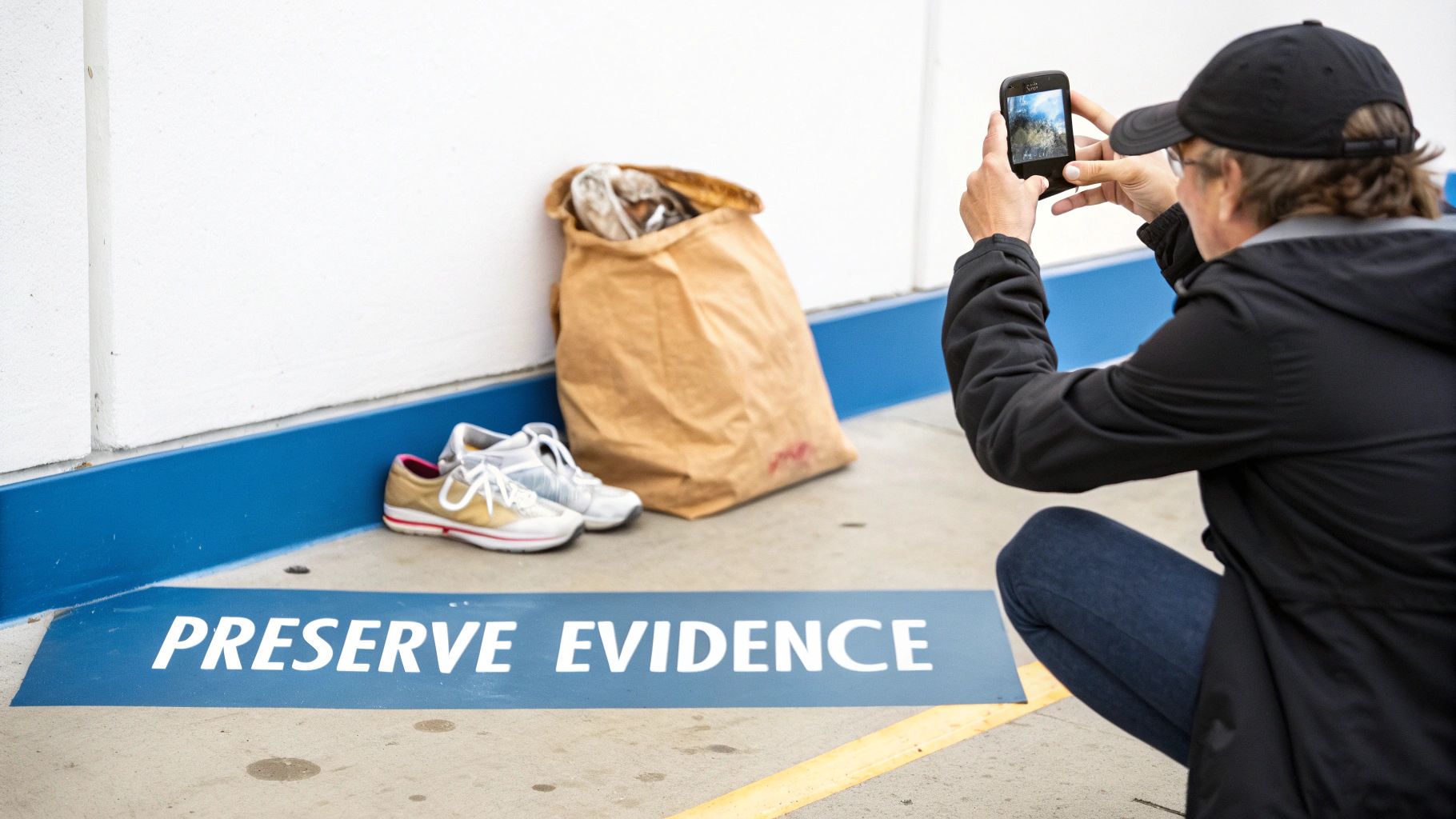
This plan is critical because property owners and their insurance companies start building their defense almost immediately. By taking these steps, you are gathering the evidence needed to build a solid foundation for your premises liability claim.
Your Immediate Action Plan
If you’ve been hurt, try to stay as calm as possible and run through this checklist. Each step is designed to preserve crucial information.
Get Medical Help Immediately: Your well-being is non-negotiable. Call 911 or get to an emergency room. Even if you think you’re “okay,” serious injuries like concussions or internal damage often have delayed symptoms. A medical evaluation creates an official record tying the incident to your injuries—this is vital evidence.
Report It Officially: Find the property owner, store manager, or landlord and inform them of what happened. Insist on filing a formal incident report and, most importantly, ask for a copy. This creates an official timestamp and documents your side of the story.
Document Everything With Your Phone: Your smartphone is your most powerful evidence-gathering tool. Take clear photos and videos of the exact hazard that caused your injury—the puddle, the broken step, the icy sidewalk, or the dimly lit hallway. Snap a few pictures of your visible injuries as well.
Gather Witness Information: If anyone saw what happened, their perspective is invaluable. Politely ask for their full name and phone number. A neutral, third-party account can dismantle an owner's attempts to dispute your claim. Our guide on how to write a witness statement explains more about why their testimony matters.
Preserve the Physical Evidence: The shoes you were wearing are now evidence. The same goes for any torn or bloody clothing. Seal these items in a bag and do not wash or wear them again. They can serve as physical proof of what happened.
A Critical Warning About Insurance Adjusters
Understand this: the insurance adjuster is not on your side. Their job is to protect their company's profits by paying out as little as possible—or nothing at all.
Never give a recorded statement to an insurance adjuster without speaking to a lawyer first. Adjusters are trained to ask leading questions designed to get you to downplay your injuries or accidentally admit partial fault. This can destroy your case under Colorado's comparative negligence rules.
Anything you say can and will be used against you. Before you speak to an insurance representative, your first call should be to get legal advice. Let an experienced attorney handle those conversations to protect your rights.
How a Denver Attorney Builds Your Case for Success
After you’ve handled the critical first steps, it's natural to wonder what comes next. How does your experience—the pain, the medical bills, the disruption to your life—turn into a solid legal claim that can hold a negligent property owner accountable?
At Conduit Law, we combine deep legal experience with a modern, tech-forward approach to build your case for maximum compensation from the moment you call us. Our job is to handle the legal complexities so you can focus all your energy on recovery.
The Investigation and Evidence Gathering Phase
The foundation of any strong premises liability case is evidence. Because memories fade and proof can disappear quickly, our team moves with urgency to investigate the incident and preserve every piece of crucial information.
This isn't a surface-level review. We dig deep to uncover the documents and data that tell the full story of the property owner’s negligence.
This often includes:
- Securing Surveillance Footage: We immediately send preservation letters demanding that property owners save any video from security cameras before it’s erased.
- Obtaining Incident Reports: We track down copies of any internal reports filed by employees. These documents can contain crucial details or even admissions of fault.
- Reviewing Maintenance and Inspection Logs: These records can be a goldmine, often revealing a history of neglect and proving the owner knew about a hazard but did nothing.
- Interviewing Witnesses: We reach out to anyone who saw what happened to get formal statements that lock in their testimony and support your version of events.
Engaging Experts and Proving Negligence
Sometimes, presenting the basic facts isn't enough to prove negligence. In complex cases, we bring in outside experts to provide authoritative analysis that can make your claim undeniable.
For instance, if you were injured when a staircase collapsed, we might hire a structural engineer to inspect it and testify that it failed to meet building codes. In a negligent security case, we could bring in a security consultant to establish that the property’s poor lighting and lack of patrols fell below reasonable safety standards for the area.
A strong case is built on a bedrock of facts and expert validation. We use specialized knowledge to draw a clear, undeniable line between the property's condition and the owner's legal responsibility.
Meticulously Documenting Your Damages
Finally, building a winning case means painting a complete picture of everything you've lost. This goes far beyond your initial emergency room bill. We meticulously document the full scope of your damages to ensure nothing is overlooked when we demand compensation.
This means calculating:
- All Medical Expenses: We account for both past and future costs, from surgeries and physical therapy to prescription medications and medical equipment.
- Lost Wages and Earning Capacity: We document every dollar of income you’ve lost. If your injuries are permanent, we calculate the long-term impact on your ability to earn a living.
- Pain and Suffering: We work to quantify the non-economic damages—the real human cost of the injury, including physical pain, emotional distress, and the loss of enjoyment of life.
Armed with this comprehensive evidence package, we approach the insurance company from a position of strength, ready to negotiate for the full and fair compensation you are owed. And if they refuse to be reasonable, we are always prepared to take your fight to court.
Your Top Questions About Premises Liability, Answered
When you’re recovering from an unexpected injury, it’s natural to have questions. To provide some clarity, we’ve put together direct answers to the most common concerns we hear from clients here in Denver.
How Long Do I Have to File a Lawsuit in Colorado?
In Colorado, the law sets a firm deadline for filing personal injury lawsuits, known as the statute of limitations. For most premises liability claims, you have just two years from the date of the incident to officially file your lawsuit.
If you miss this deadline, the door to seeking compensation closes—almost always for good. It doesn’t matter how clear the property owner’s fault was or how severe your injuries are. This two-year window is precisely why it’s so critical to talk to an attorney as soon as you can.
What Happens If I Was Partially at Fault?
This is one of the most common questions we get. The answer comes down to Colorado's "modified comparative negligence" rule. In simple terms, the law recognizes that sometimes, an accident isn’t 100% one person’s fault.
Here’s how it works for your case:
- You can still recover damages as long as a jury finds you were less than 50% responsible for what happened.
- Your final compensation will be reduced by your percentage of fault. For example, if you’re awarded $100,000 but found to be 20% at fault, your award is cut by $20,000, leaving you with $80,000.
- But if you’re found to be 50% or more at fault, you are legally barred from recovering anything.
Can I Sue If I Was Injured on Government Property?
Yes, you can sue a government body for an injury on public property, like a slip at a city park or a fall in a state building. However, the process is completely different and far more demanding than suing a private owner. These cases fall under the Colorado Governmental Immunity Act (CGIA), which has its own strict rulebook.
The most crucial difference is the notice deadline. Forget the standard two-year statute of limitations. The CGIA requires you to file a formal, written notice of your claim within just 182 days of the injury.
If you miss this tight deadline, your right to sue is gone. Navigating a CGIA claim is not something you should do alone; it requires an attorney who knows the intricate procedures for holding government entities accountable in Colorado.
This blog post is for informational purposes only and does not constitute legal advice. Every personal injury case is unique, and past results do not guarantee future outcomes. Contact Conduit Law for a free consultation.
Let Conduit Law handle the legal complexities while you focus on recovery. Contact us today at (720) 432-7032 or visit us online at https://conduit.law.
Written by
Conduit Law
Personal injury attorney at Conduit Law, dedicated to helping Colorado accident victims get the compensation they deserve.
Learn more about our team

